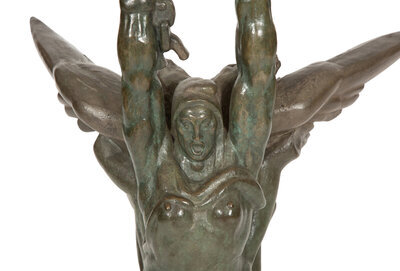Condition Report
Contact Information
Auction Specialist
Lot 91
Donald de Lue
(American, 1897-1988)
Victory, Freedom with Wings
Sale 2105 - American Art and Pennsylvania Impressionists
Dec 8, 2024
2:00PM ET
Live / Philadelphia
Own a similar item?
Estimate
$8,000 -
12,000
Price Realized
$6,350
Sold prices are inclusive of Buyer’s Premium
Lot Description
Donald de Lue
(American, 1897-1988)
Victory, Freedom with Wings
bronze with dark brown patina
signed DeLue, dated sc. 1942 and © 1986, numbered 3/12, and stamped with the TX monogram for the Tallix Foundry in Beacon, New York (lower edge of the bronze)
height: 31 1/2 in.
Provenance:
Private Collection, Rhode Island.
Literature:
D. Roger Howlett, The Sculpture of Donald De Lue: Gods, Prophets, and Heroes, Boston, 1990, pp. 62-63; 67 (another cast illustrated).
Lot Essay:
With a career spanning sixty years, the artist Donald De Lue is considered one of 20th century America’s greatest monumental sculptors in the Realist style. Born in 1897 in Boston, at the age of 12 he apprenticed with Boston sculptor Richard Recchia, and later studied with Bela Pratt at the Museum of Fine Arts, Boston, as well as Robert Baker. After World War I, De Lue spent five years in France, where he worked for several sculptors, including Alfredo Pena. It was under these sculptors’ influence that he learned to sculpt the human body accurately and from memory and began to break away from literal interpretations of his subjects. After he returned to the United States, the artist served from 1923-1938 as chief assistant to the portrait sculptor Bryant Baker in New York City. With Baker, he honed his skills and became known as a “sculptor’s sculptor” for his mastery of anatomy. By the late 1930's, De Lue had developed his mature style, and his own career began to flourish.
“His sculpture demonstrates artistic links to both Greco-Roman and late Renaissance sculptors,” writes Jonathan L. Fairbanks, Emeritus Curator of American Figurative Sculpture Catalogue, Museum of Fine Arts, Boston. “He emulated the exuberant gestures and energetic composition such as those found at Pergamum. The mature Michelangelo especially inspired De Lue to compose his figures with mannerist proportions, emphasized with highly articulated musculature. However, by combining these older influences with the ideas and techniques acquired during his stay in Europe… De Lue developed his own synthesis. As he admitted, 'Although my work is traditional, it is a tradition of my own’.”
The artist first won recognition in 1938 as runner-up in a competition for the Federal Trade Commission Building in Washington, DC. Several government commissions followed, the first of which were reliefs for the Philadelphia courthouse, completed in 1940. In the next almost fifty years, De Lue probably executed more monumental commissions than anyone else of his generation. Most notable are his works Spirit of American Youth Rising from the Waves for the Omaha Beach Memorial in France and Rocket Thrower for the 1964 World's Fair in Flushing Meadows, New York. He was also an accomplished medalist and a member of the National Sculpture Society.
De Lue’s use of classical mythology and the personification of spiritual ideas is represented in the present group of four sculptures, which also spans the artist’s lengthy career. Jupiter as the Bull (Lot 62) draws on Greek mythology and presents the bull as an animal of supernatural strength that exuberantly cavorts through space. With Victory, Freedom with Wings, the artist “…imbues “his Nike with American attributes. The Greek goddess of victory was not invested with attributes of either freedom or liberty, yet De Lue has his Nike breaking the manacles of slavery and wearing the cap of liberty. This design was conceived as a monument to the battle of Corregador to be erected at Manila in the Philippines” (D. Roger Howlett, Donald De Lue; Gods, Prophets, and Heroes” 1990, p. 65). Hand of God represents a theme De Lue returned to many times, that of the story of creation. Here, Michelangelo's influence is felt through the artist’s exploration of contrapposto and the figura serpentina in his figure of Adam being held alone in the hand of the creator. The upward motion of the powerfully modeled Joy of Life embodies the limitless spirit of vigorous youth. Together, the group characterizes De Lue’s desire to “give dignity to the man, not make a hero of De Lue.”













